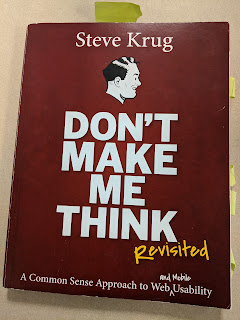January Book: Don't Make Me Think
One of my goals for this year is to read a book per month that's related to my work. I've already finished the book for January, mainly because I had started it last year, but hey, it counts! Anyhow, the book is Don't Make Me Think by Steve Krug. While it is a little dated with respect to mobile UX at this point (this 3rd edition was published in 2014), it was a very useful read with lots of specific, actionable advice. So much so that I had to give up on trying to bookmark every useful thing and just created a long list of ideas and items to discuss with my fellow devs instead.
I highly recommend this book if you, like me, are a dev who is responsible for user interfaces without having (almost) any formal training on UI or UX. In other words, most devs from a traditional CS background... Argh. But anyhow, it really is a great resource for simple, specific ways to improve your user interfaces. We're definitely going to redesign our navigation based on the great tips in here, and I've finally been convinced that we both can and should do some amount of usability testing, too.
I've taken a formal user experience research class through NMSU's CS department (thanks to that sweet, sweet, free tuition for NMSU employees), and while it was very interesting and I did learn some useful things (Tufte's Envisioning Information alone was a revelation, and well worth a read all on its own), it assumed a much larger organization with a dedicated UX team or at least a dedicated UX person. This made the whole process seem completely out of reach for our tiny IT team (which, as I like to point out, is the far more common scenario: big companies get all the press, but tiny teams are the norm). So I truly appreciated this book's much more stripped-down approach, exemplified by the chapter entitled "Usability testing on 10 cents a day". Granted this still assumes a much larger, more resourced team and of course it assumes you're creating commercial apps for paying customers (my perennial frustration), so I will have to simplify the process even further. Still, this is the first time I ever felt it was actually a possibility for our organization, and I'm pretty stoked.
Basically, this book is the entire reason I have usability testing as one of my goals for the year. It's good stuff, and more immediately I think it'll help us improve the navigation in our existing apps. Two thumbs up!
Next up: Designing UX: Forms by Jessica Enders.
Next up: Designing UX: Forms by Jessica Enders.



Comments
Post a Comment